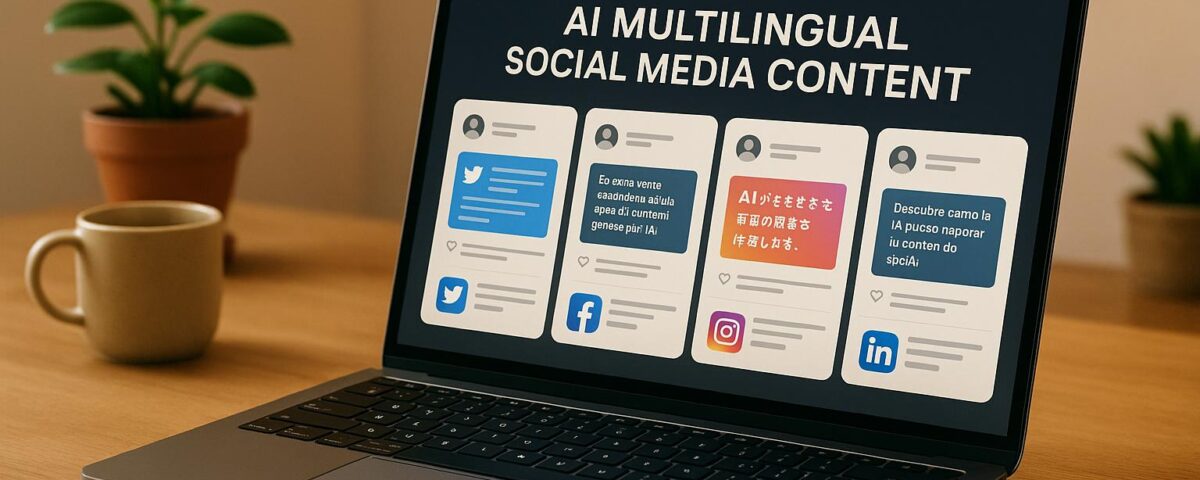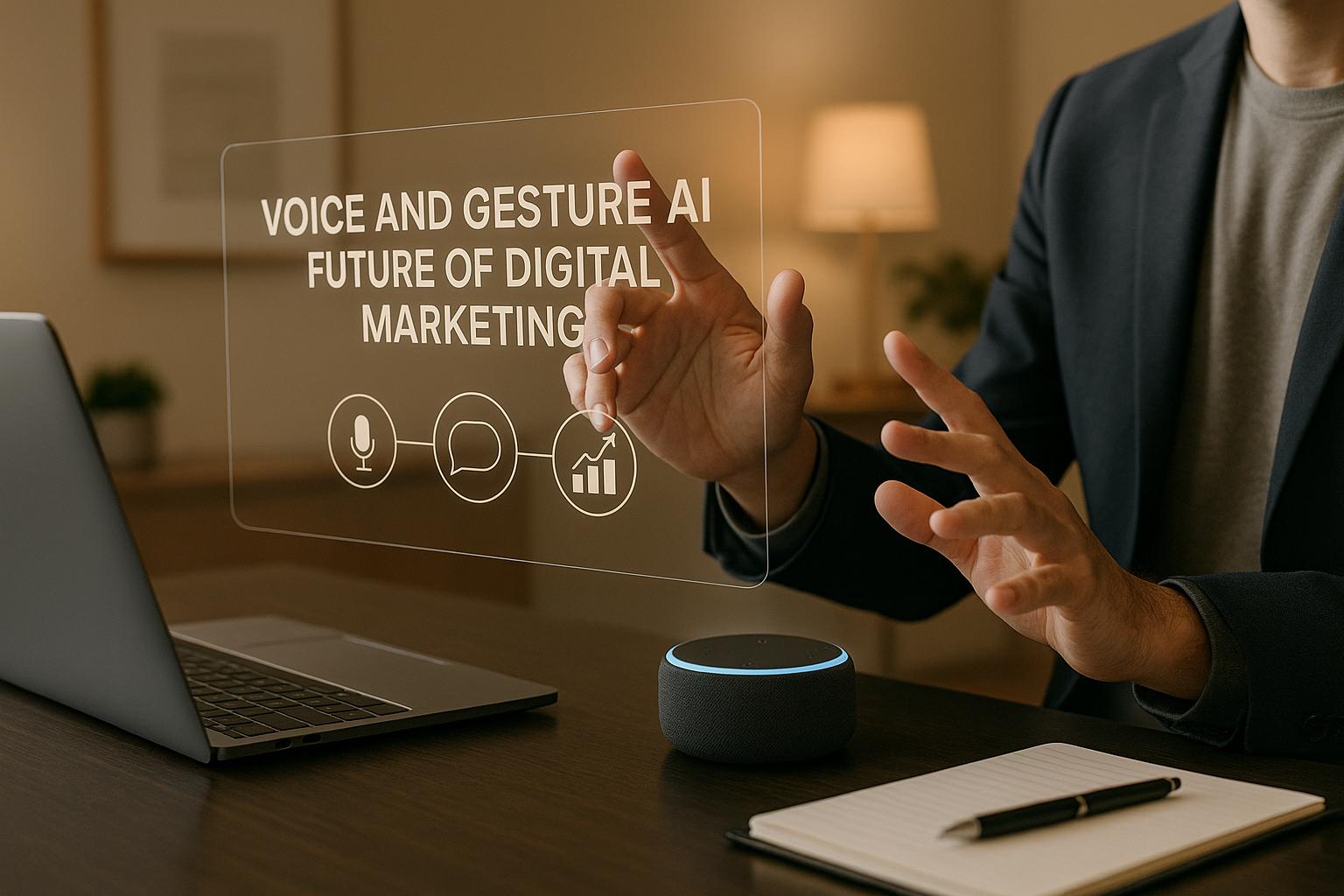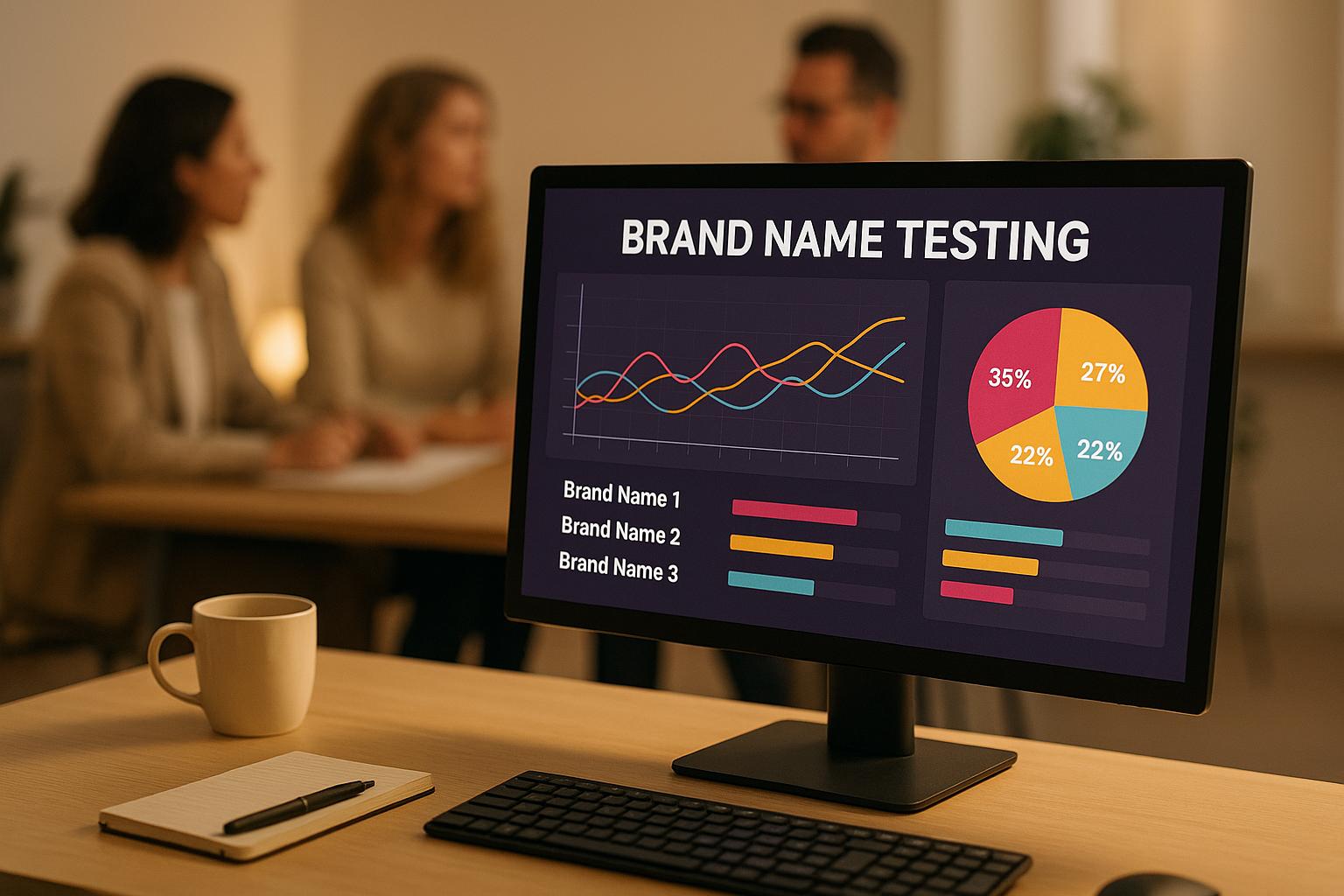AI is transforming how businesses create multilingual social media content, making it faster, scalable, and more efficient. Here’s what you need to know:
- Why it matters: 72% of consumers prefer buying in their native language, and 60% avoid English-only websites. Multilingual content helps businesses connect with global audiences.
- How AI helps: AI tools streamline translation, localization, content creation, and scheduling. They also optimize visuals, videos, and SEO for multiple languages.
- Best tools: Platforms like DeepL, Google Translate, Buffer, and Synthesia simplify translations, scheduling, and multimedia content creation.
- Key practices: Tailor content to regional preferences, optimize for specific platforms, and combine AI efficiency with human review for accuracy and tone.
AI tools reduce costs, save time, and improve global reach. Businesses that integrate AI with human oversight can better engage diverse audiences and build stronger connections worldwide.
3 Multi-Language Social Media Strategies for Small Businesses to Large Brands
Best AI Tools for Multilingual Social Media Content
AI tools have become indispensable for managing multilingual social media strategies. With 96% of companies planning to adopt generative AI by 2025, choosing the right tools is more important than ever [2]. These platforms simplify tasks like translation, localization, content creation, and scheduling, making it easier for businesses to connect with global audiences. Below, we explore key categories of AI tools that help ensure accurate translations, efficient scheduling, and culturally relevant visuals.
AI Translation and Localization Tools
Translation tools are the backbone of any multilingual social media strategy. While Google Translate processes a staggering 100 billion words daily [5], it’s important to choose tools that offer more than just basic translations.
- DeepL Translate: Known for its precision, DeepL excels at maintaining tone and context, making it perfect for social media posts that need to preserve their original voice. Although it supports fewer languages than Google Translate, its accuracy often makes it worth the investment for businesses that value brand consistency.
- Google Translate: With support for over 100 languages, Google Translate is a go-to option for quick and accessible translations. Its integration capabilities are a plus, though it may fall short when it comes to capturing subtle cultural nuances.
- Memsource: This tool is built for professional-grade translations, featuring translation memory that ensures consistency across campaigns. It integrates seamlessly with social media management tools, but its complexity and cost might be a hurdle for smaller businesses.
- iTranslate: A budget-friendly option, iTranslate offers a simple interface and handles basic social media translations effectively. It’s ideal for companies just starting to branch into multilingual content.
AI Content Creation and Scheduling Platforms
Creating and scheduling content in multiple languages is another challenge that AI tools help address. These platforms streamline the process by generating content directly in different languages and scheduling posts across various channels.
- Buffer: With its AI Assistant priced at $5/month per channel (billed annually), Buffer simplifies content creation and scheduling. It’s user-friendly and helps tackle creative fatigue by offering up to 2,000 content ideas [3].
- ContentStudio: Starting at $19/month (billed annually) for 5 social accounts, ContentStudio combines content creation, translation, and scheduling in one platform. It supports multilingual campaigns with up to 10,000 AI-generated words and 10 AI-generated images per month [3].
- Hootsuite: Designed for enterprise users, Hootsuite’s Standard plan starts at $149/user/month (billed annually) [3]. It includes unlimited posts, advanced scheduling, a unified inbox for multilingual interactions, and comprehensive analytics.
- Predis.ai: For $27/month (billed annually), Predis.ai offers 60 AI-generated posts and competitor analysis runs, creating content tailored to different languages and cultural contexts [3].
- Publer: A cost-effective option for smaller budgets, Publer’s Professional plan is available at $4/month per channel (billed annually) [3]. It provides essential multilingual scheduling features.
AI Visual and Video Content Tools
Visual content plays a crucial role in engaging audiences across language barriers. From localized videos to culturally relevant imagery, these tools help businesses bridge gaps in visual communication.
- Synthesia: Offering plans starting at $22/month for beginners, Synthesia creates multilingual videos featuring AI avatars. It’s a great choice for product demos and other video content.
- Invideo AI: This platform provides versatile video creation options, including a free plan, a Plus package at $20/month, and a Max package at $48/month [6]. It’s particularly effective for faceless video content, which appeals to global audiences.
- Fliki: Specializing in text-to-video conversion, Fliki includes multilingual voiceovers and automatic subtitles. Plans range from a free version to a premium package at $66/month [6].
- Runway: A professional-grade video editing tool, Runway offers AI-assisted features like automated dubbing and cultural adaptation of visuals. Pricing starts with a free plan and goes up to $76/month for an unlimited option [6].
While these tools streamline workflows and make multilingual content creation more efficient, human oversight is still essential. AI can handle many tasks, but understanding cultural nuances and local preferences often requires a human touch to ensure content resonates with diverse audiences.
How to Create Effective AI Multilingual Social Media Content
Creating multilingual content that resonates with global audiences requires more than just translating text. It’s about crafting messages that build trust, drive engagement, and inspire action across diverse markets. To achieve this, you need to tailor your content to align with regional preferences and platform-specific norms.
Adapting Content for Different Languages and Regions
Localization is the secret to connecting with audiences on a meaningful level. This involves weaving in local expressions, humor, and values that feel authentic to each region.
AI can play a key role here by understanding subtle contextual differences while preserving the original intent of your message. It can even help fine-tune visual elements to fit cultural expectations. For instance, colors, symbols, and gestures can carry vastly different meanings depending on the region – what works in the U.S. might not translate well in Japan or Brazil [4][7].
Start with thorough market research to uncover cultural nuances and social media behaviors in each target region [4]. AI tools can analyze local feedback, identify trending platforms, and highlight influential voices, providing insights into what kind of content performs best.
Adjust the tone and style of your messaging to align with cultural expectations. A casual, witty tone might resonate with U.S. audiences on Twitter, while a more formal approach might be better suited for LinkedIn users in Germany. AI can help refine references, idioms, and cultural touchpoints to ensure content feels natural to each audience while maintaining the core message [4][8].
Once your text and visuals are tailored, the next step is adapting your posts to match the style of each social media platform.
Optimizing Content for Different Social Media Platforms
Every social media platform has its own personality and set of best practices, which become even more nuanced when you’re managing multilingual content. Adapting your strategy to each platform is essential for maximizing engagement.
- Facebook: Keep posts concise – around 111 characters – and limit hashtags to one or two [10]. For videos, include closed captions to boost accessibility and engagement across language barriers. AI can generate captions in multiple languages quickly and accurately.
- Instagram: Focus on compelling visuals paired with strategic hashtag use. Hide hashtags in the comments for a cleaner look, and include multilingual hashtags that align with your audience’s interests.
- LinkedIn: Maintain a professional tone and use industry-specific language [10]. When targeting international audiences, add bilingual titles to your posts and include hashtags that reflect professional terminology in each language.
- TikTok and Instagram: A dual-language approach works well here. Use English as the primary language while adding captions, subtitles, and hashtags in multiple languages to expand your reach [9].
Timing is also critical. Use scheduling tools to post during peak activity hours for each region [1]. AI can analyze engagement patterns and recommend the best times to post for each platform and language.
Take inspiration from successful brands. For example, Herschel Supply uses geotagging on Instagram to highlight location-specific products, like umbrellas for London weather. This approach shows how combining platform features with localized messaging can drive engagement [10].
Using AI with Human Review
Even with AI’s efficiency, human oversight remains essential to ensure your content strikes the right tone and aligns with your brand’s identity. While AI can handle repetitive tasks, humans bring the creativity and cultural awareness that make content truly impactful.
"Always have a person review AI-generated content for tone, accuracy, and brand consistency before you hit publish." – Leah Messenger, Content Marketing Manager, Optimizely [11]
Establish a review process. Train your team to identify errors or inconsistencies that AI might overlook. Fact-check all statistics and claims, especially when translating content across languages where meanings can shift [12][13].
Add a human touch. Use your team’s creativity to rework dull AI-generated sentences into engaging ones. Include anecdotes, customer success stories, or expert insights that AI might not have access to [13]. Strong hooks and a refined tone can make your content more compelling.
Cultural accuracy is key. Have native speakers or cultural experts review your content for each market. They can flag references that don’t translate well, suggest local alternatives, and ensure your content feels genuine rather than machine-generated.
The goal isn’t to replace AI but to create a partnership where AI handles repetitive tasks and humans provide the cultural and creative expertise needed to make your content resonate across languages and regions.
Best Practices for US-Based Businesses
For businesses operating in the US, creating effective multilingual content with AI requires more than just translation. It involves meeting localization standards, ensuring accessibility, and continually improving AI performance to match local expectations.
US Localization Standards
When crafting AI-generated content for the US market, it’s essential to adapt it to American norms and preferences. This goes far beyond simple word-for-word translations – every detail must align with local conventions.
Start by following language and formatting guidelines specific to the US. Use American English spelling, such as "color" instead of "colour" or "organize" instead of "organise." Dates should follow the MM/DD/YYYY format (e.g., 12/25/2024), and currency should be displayed with the dollar sign before the amount (e.g., $19.99). For measurements, stick to the imperial system, such as feet, inches, and Fahrenheit.
"Localization is the process of adapting your content to a new market by aligning it with local languages, idioms, humor, and cultural norms. This includes, but is not limited to, text, images, and website elements and layout." – Vistatec [16]
To ensure consistency, develop style guides that outline US English preferences, cultural nuances, and your brand’s tone. For instance, Bethesda Game Studios effectively uses AI localization tools for their game "The Elder Scrolls V: Skyrim", ensuring that elements like dialogue, subtitles, and user interfaces are culturally appropriate for their audience [14].
Uploading glossaries and style guides into your AI tools can help maintain a consistent brand voice across languages. Additionally, native linguists play a key role in catching subtle issues, such as symbols or idioms that might not translate well in other regions [16].
Making Content Accessible and Inclusive
Accessibility isn’t just about meeting legal requirements like WCAG, ADA, or Section 508 – it’s also about reaching a broader audience. AI can simplify this process by automating compliance checks and ensuring your content is inclusive.
AI tools can flag issues like missing alt text, poor color contrast, or inaccessible layouts before content is published [17]. For example, Microsoft incorporates AI-powered tools to provide automatic translations and captions during virtual training sessions, making them more inclusive [17].
To make your content accessible, use clear language, avoid unnecessary jargon, and include alternative text descriptions for images. Ensure interactive elements are labeled clearly, and maintain proper color contrast for readability. Regular training for your team on how to use these AI features effectively, along with routine audits, can help maintain compliance as standards evolve.
One example of this in action is a mid-sized tech company that used AI to perform real-time accessibility checks for employee training programs. This reduced manual work while ensuring ADA compliance [17]. Similarly, Stanford employs AI platforms to simplify dense academic materials and create alternative learning paths for neurodiverse students [17].
Tracking and Improving AI Performance
Localization and accessibility efforts are most effective when paired with ongoing performance tracking. Measuring how your AI-generated content performs allows you to refine your strategy and achieve better results.
Track engagement metrics by region to see how well your content resonates with specific audiences. Companies that integrate AI into their social media strategies often see engagement rates increase by 15% to 25% [19]. Use AI tools with robust analytics to identify which content performs best in specific languages or regions and adjust your approach accordingly.
Sentiment analysis is another valuable tool for understanding audience reactions. By analyzing feedback, you can tweak your AI models to better align with cultural expectations and avoid missteps like offensive translations or inappropriate imagery [1].
One standout case is Mouser Electronics, which partnered with Welocalize to implement OPAL-Marketing. This AI-powered solution automated translation workflows, freeing up their team to focus on creating more engaging content [18].
"AI is the umbrella term for the algorithms, technologies, and techniques that make machines smart and give marketers superhuman capabilities." – Paul Roetzer, Founder, Marketing AI Institute [19]
You can also streamline workflows by connecting AI tools to platforms like HubSpot or Zapier. These integrations allow for seamless translation and scheduling of multilingual content across time zones. Establishing review processes ensures that errors are caught before content goes live.
The importance of these efforts is clear: 72.1% of consumers are more likely to purchase a product if information is available in their native language [1]. To meet this demand, prioritize AI tools that offer features like multilingual content generation, cultural tone detection, language translation, and detailed analytics by region or language [1].
sbb-itb-c00c5b1
Future Trends in AI Multilingual Content
The world of AI-driven multilingual content is advancing at an incredible pace. These developments are reshaping how businesses approach social media and content creation, blending automation with human expertise to create smarter strategies.
New Developments in AI Translation and Localization
Large Language Models (LLMs) are changing the game in multilingual content creation. Unlike older machine translation systems that often delivered clunky, literal translations, LLMs are adept at understanding context and subtleties that make translations feel more natural and relatable.
"LLMs produce contextually rich and fluent translations that can often capture nuance and tone more effectively than traditional machine translation." – TransPerfect Team [20]
Modern AI systems also adapt in real time, learning from user feedback, specialized glossaries, and even your brand’s unique voice [21]. With every project, these tools align more closely with your communication style, delivering progressively better results.
Hyper-personalization is another leap forward. AI now analyzes user behavior, regional trends, and cultural preferences to create content that feels tailor-made for each audience [20]. Instead of offering generic translations, businesses can provide localized experiences that resonate deeply.
Multimedia content is also benefiting from AI advancements. Tools for voice synthesis and automated subtitles now make it easier than ever to adapt videos for global audiences. Real-time voice-to-text translation is becoming increasingly accurate, meeting the growing need for accessible, multilingual communication [21].
In specialized industries like legal, medical, and technical fields, AI systems are proving invaluable. These tools are designed to handle complex terminology and meet strict regulatory requirements, making them essential for businesses in these sectors [21].
Automation and Scaling Up
Automation is taking multilingual content to new heights, making it faster and more efficient to scale. Today, 73% of businesses use AI for content creation, cutting production time by an impressive 50% [26].
Machine-assisted translation has become a cornerstone of language workflows, now powering 70% of them [23]. The financial benefits are clear: AI tools can slash localization costs by up to 60% and reduce time to market by as much as 80% [15].
Integration is also improving. AI translation tools now sync seamlessly with product development pipelines, ensuring multilingual updates roll out alongside new features [21].
Quality assurance, once a labor-intensive process, is now largely automated. AI-driven tools catch translation errors, inconsistencies, and formatting problems, cutting errors by up to 50% and saving around 2,000 hours of manual work with 80% less effort [15].
For social media, automation ensures consistent posting across time zones while tailoring content to different audiences. These tools analyze regional engagement trends and adjust posting times and formats for maximum impact.
Combining Human Skills with AI
While automation handles much of the heavy lifting, human expertise remains crucial for perfecting content. AI takes care of repetitive tasks like initial translations and quality checks, freeing up human professionals to focus on creative and strategic aspects [21].
Human translators are evolving into roles like prompt engineers and quality reviewers, guiding AI systems to deliver better results [22]. This partnership is especially effective for brand-sensitive content, legal documents, and creative campaigns where precision and cultural nuance are non-negotiable [24].
A/B testing with native speakers is another way to refine AI outputs. Their feedback helps train systems to better understand regional differences and cultural sensitivities [25]. This process ensures that AI-generated content aligns with audience expectations.
AI systems are also improving in their ability to capture and maintain brand voice. By incorporating style guides and glossaries, businesses can ensure consistency across languages while preserving their unique identity [15].
These trends highlight a collaborative future where AI and human expertise work hand in hand. Businesses that embrace this partnership will be well-positioned to engage diverse audiences effectively, combining the efficiency of technology with the creativity and cultural understanding that only humans can provide.
Conclusion
AI is reshaping the way multilingual social media content is created, making global communication more accessible and impactful. With over 75% of consumers favoring websites in their native language and nearly 60% steering clear of English-only platforms [25], the demand for localized content is undeniable. Considering that only 25.9% of the 5.35 billion internet users worldwide are native English speakers [25], businesses have an incredible opportunity to broaden their reach through multilingual strategies.
From a financial standpoint, AI significantly reduces costs, cutting production expenses by up to 40% and slashing research time by 60–70% [27]. Unlike older translation methods, today’s AI tools go beyond basic word-for-word translation, taking into account sentence structure, idioms, and tone to ensure the content feels natural and engaging.
The most successful approaches combine AI’s efficiency with human creativity. While AI handles repetitive tasks, human creators can focus on storytelling, strategic planning, and maintaining a consistent brand voice [27]. This partnership ensures that translations are not only accurate but also culturally relevant, resonating deeply with diverse audiences.
To maximize the impact of AI-driven content, businesses should test outputs with native speakers, tailor content to cultural nuances, and maintain a unified brand identity across all languages. This method helps forge genuine connections with global audiences while delivering personalized experiences at scale.
AI-powered multilingual content is breaking down language barriers and fostering deeper connections with audiences worldwide. For businesses aiming to grow their global presence, this technology offers an efficient and scalable way to engage diverse communities and build meaningful relationships.
If you’re ready to explore the possibilities, My Rich Brand’s AI-driven digital marketing services can help you combine the speed and precision of AI with human expertise. Together, we can craft multilingual social media strategies that truly resonate with audiences around the globe.
FAQs
How can businesses use AI and human expertise to create culturally accurate multilingual social media content?
Creating Multilingual Social Media Content That Resonates
Crafting multilingual social media content that feels authentic and culturally appropriate can be tricky. Luckily, AI tools can help streamline the process by generating translations and initial drafts quickly. But here’s the key: human expertise is essential to fine-tune and adapt that content. This ensures it reflects cultural nuances, matches local preferences, and stays true to your brand’s voice – all while steering clear of any potential missteps or misunderstandings.
To get the most out of this approach, start by using AI to create multiple variations of your content. With specific prompts or rules, you can shape the AI’s output to suit your needs. Then, let human reviewers step in to refine the tone, adjust for context, and address ethical considerations. This collaboration balances the speed and efficiency of AI with the creativity and judgment that only humans can provide, resulting in content that genuinely connects with diverse audiences.
How can I optimize AI-generated content for different social media platforms and regional audiences?
To make AI-generated content shine on different social media platforms and resonate with regional audiences, it’s all about customizing for platform-specific formats and aligning with local preferences. This means adjusting the tone, visuals, and messaging to suit the unique vibe of each platform while keeping regional trends, language variations, and audience interests in mind.
For regional appeal, AI tools can be a game changer. Use them to analyze local data, spot trending topics, and forecast how content might perform. By weaving in culturally relevant themes, local holidays, and events, your posts will feel more relatable and timely. At the same time, ensure your content is easy to understand, visually appealing, and engaging for a wide range of audiences.
AI can also help refine your strategy by suggesting effective keywords, optimizing content schedules, and tracking performance metrics. These insights allow you to fine-tune your approach for each platform and region, boosting engagement and making your content stand out.
How can AI tools ensure consistent branding across different languages and cultures?
How AI Tools Help Maintain Consistent Branding Globally
AI tools are game-changers when it comes to keeping your branding consistent across different languages and regions. They adapt your content to fit local contexts while staying true to your brand’s voice and style. By analyzing subtle linguistic differences, regional preferences, and emotional tones, these tools ensure your message connects with diverse audiences without losing its core identity.
With features like translation memory, style guides, and advanced localization algorithms, AI simplifies the process of crafting messaging that’s both culturally appropriate and aligned with your brand. This means businesses can maintain a cohesive global image while speaking directly to customers in their native language. It’s like having a global branding expert at your fingertips.





